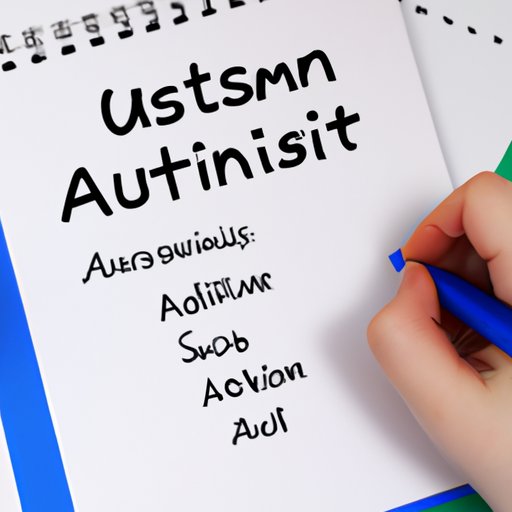Introduction
Autism Spectrum Disorder (ASD) is a developmental disorder that affects how a person communicates, interacts, and processes information. The disorder is complex, and its symptoms vary from one person to another. In this article, we will discuss the signs and symptoms of autism, getting a diagnosis, personal accounts from people on the spectrum, understanding co-occurring conditions, and navigating your diagnosis.
Signs and Symptoms
ASD affects an estimated 1 in 54 children in the United States. The signs and symptoms of autism can be observed in children as young as 2 years old. Usually, symptoms of autism are observable in the first two years of life.
Common social difficulties of autism include avoiding eye contact, difficulty empathizing with others, difficulty interpreting social cues, and difficulties with appropriate emotional responses. Many autistic people experience sensory sensitivities such as intolerance to certain sounds, strong lights, or certain fabrics. Some autistic people may engage in repetitive behaviors such as flapping their hands or rocking back and forth.
Real-life examples and scenarios can help people understand autism symptoms better. For instance, an autistic child may prefer to play alone, avoid making eye contact with others, have difficulty sharing or taking turns, or become upset when routines change. An autistic adult may avoid social gatherings, have difficulty making friends, struggle in employment, or engage in repetitive behaviors.
Getting a Diagnosis
Getting a diagnosis is the first step towards understanding and managing autism. A diagnosis can be conducted at any age, but it is usually done in childhood. The diagnostic process involves comprehensive assessments by doctors, psychologists, and other healthcare professionals.
Diagnostic tests and evaluations used to diagnose autism include behavioral observations, cognitive tests, speech and language assessments, and genetic testing. The diagnostic process usually takes a few weeks or months, and it is tailored to the individual needs of the person being evaluated.
Preparing for the evaluation can help make the process more comfortable. Parents can bring notes, documents, or videos that show their child’s symptoms, history, and milestones. Adults getting an assessment should collect all relevant medical history, educational reports, or previous assessments to help the evaluator understand the person’s symptoms and needs better.
Personal Accounts
Personal accounts from people who have autism can help others understand the disorder from a unique perspective. Autistic people report feeling misunderstood, anxious, and overwhelmed in social situations, school, or work. However, with support and accommodations, many autistic people thrive in their lives.
Many people who have autism may take some time to recognize and accept their diagnosis. Coming to terms with the diagnosis can involve dealing with a sense of shame or fear of the stigma attached to the disorder. However, once they come to terms with the diagnosis, many find it empowering and use it as a way to express their identities, connect with others, and educate the public about autism.
The benefits of getting a diagnosis include understanding what the person needs to help manage their symptoms and promote their well-being. The diagnosis can help autistic people get accommodation in their workplace, school, or public places. They can also access resources, such as therapies, support groups, and educational programs that can help improve their lives.
Understanding Co-Occurring Conditions
It is common for autistic people to have co-occurring conditions that can affect their diagnosis, treatment, and life. For instance, Attention Deficit Hyperactivity Disorder (ADHD), anxiety disorders, Obsessive-Compulsive Disorder (OCD), depression, and mood disorders can co-exist with autism. Co-occurring conditions can interact with each other, intensifying the symptoms and making it harder to identify and manage the conditions.
Understanding co-occurring conditions can help autistic people and their families to cope better and ensure the best possible care and treatment. Treating other co-occurring conditions can improve the autistic person’s quality of life, make social relationships easier, and reduce distressful symptoms.
Navigating Your Diagnosis
After getting an autism diagnosis, autistic people and their families have many choices to make. Depending on the person’s age, developmental level, symptoms, and co-occurring conditions, they can decide which therapies, treatments, and educational programs can benefit them. For instance, many autistic people benefit from cognitive-behavioral therapy (CBT), speech and language therapy, occupational therapy, social skills training, or medication treatments.
Explaining the diagnosis to family, friends, and colleagues can feel overwhelming for some people, especially if they worry about being misunderstood or rejected. It is essential to take the initiative to inform others about the diagnosis and educate them about the disorder’s symptoms and needs. In most cases, educating others about autism can improve the person’s social network, promote empathy and acceptance, and reduce misunderstandings.
It is also crucial to find and connect with support groups and resources that can provide information, guidance, and emotional support. Resources such as parent groups, advocacy organizations, or online social networks can help autistic people and their families to connect with others who have similar experiences, share stories, find resources, and receive support and encouragement.
Conclusion
Autism is a neurodevelopmental disorder that affects communication, social interaction, and behavior. While many people have heard of autism, they may not fully understand its complexity, which is why accessing resources, support, and education can be so beneficial. With this article, we hope that we have been able to shed light on some of the diagnostic processes, symptoms, and treatment options that can help people with autism thrive.
Recognizing, accepting, and embracing an autism diagnosis can be challenging, but with the right support and resources, it is possible to live a happy, successful, independent life.
